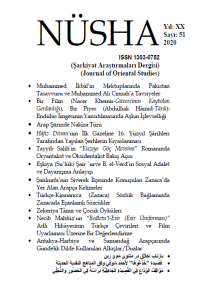A Movie (Nacer Khemir-The Dove’s Lost Necklace), A Theatre Play (Abdülhak Hâmid – Târık): Love’s Functionality In the Reflection Of Andalus Image
Öz
Al-Andalus, as a climax for Islamic civilization, arouses the interest of both literature and cinema. For that remarkable reason, the interest towards Andalus, fictionalized as an “ideal” more than an environment, appears in the second half of the 19th century in Turkish literature. This is a period through which Ottoman Empire kept declining and people tried to find means to sustain the Empire. Abdülhak Hâmid’s theatre play Târık yahut Endülüs’ün Fethi (1879) (Târık or The Conquer of Al-Andalus), in such a period for the Empire still holding the caliphate which is the key of an earthly authority of Islam, reaches a significance as an historical narrative in accordance with putting forward the terms like “conquest” and “heroism” on the basis of Andalus image. However, Hâmid combined the idealized Andalus image, and accordingly the themes “conquest” and “heroism” with earthly love, and the concept of love became a helpful pattern to idealize Andalus. Tunisian director Nacer Khemir’s movie The Dove’s Lost Necklace (1991) presents a similar Andalus idealization with a viewpoint from Arab world. Furthermore, similarly to Hâmid’s play, love becomes once again a helpful pattern in fictionalizing an ideal-Andalus. By revealing two different viewpoints from İslamic civilization, one of Abdülhak Hâmid, who is an Ottoman intellectual and Reform period author, and the other of Tunisian director Nacer Khemir, this article discusses how those two artists idealized the concept of al-Andalus and interpreted that idealization in the age they lived. Positioning the woman within the context of love as a helpful pattern in those artworks is the collateral subject to the article.
Kaynakça
- Abdülhak Hamit (1975). “Son baskıya önsöz”. Tarık. İ. Enginün. (Yay. haz.) İstanbul: Devlet Kitapları, IX–X.
- Armes, R. (2010). “The poetic vision of Nacer Khemir”. Third Text, 24. 1, 69—82.
- Awadalla, M. (1995). “Giriş”. “A wanderer seeking the words of love in impossible cities: Nacer Khemir”. Nacer Khemir’le söyleşi. Alif, 15, 251–254.
- Bezirci, A. (2000). Abdülhak Hâmit–Monografi. İstanbul: Evrensel Basım Yayın.
- Enginün, İ. (1975). “Önsöz”. İ. Enginün (Yay. haz.). Tarık (s. III–VIII) içinde. İstanbul: Devlet Kitapları.
- Khemir, N. (Yönetmen) (1991). Güvercinin kaybolan gerdanlığı. Sen. Nacer Khemir. Oyun. Navin Chowdhry, Walid Arakji, Ninar Esber ve diğer. DVD. Tunus: Carthago Films–La Sept / Paris– Italian International Film / Rome–Carthago Films–APEC–RTT.
- Kheyati, K. (1995). “A wanderer seeking the words of love in impossible cities: Nacer Khemir”. Nacer Khemir’le söyleşi. Maggie Awadalla (Çev.) Alif ,15, 255–259.
- Noakes, G. (1993). “The other 1492”. Aramco World, 44.1, 2–9.
- Simarski, L. T. (1992). “Through North African eyes”. Aramco World, 43.1, 30–35.
- Tanpınar, A. H. (2007). 19. asır Türk edebiyatı tarihi. Abdullah Uçman (Yay. haz.). 2. Basım. İstanbul: Yapı Kredi Yayınları.
- Tarhan, A. H. (1975). Tarık. İnci Enginün (Yay. haz.). İstanbul: Devlet Kitapları.
- Uğurcan, S. (2004). “Türk edebiyatında Endülüs imajı: fetih-yükselme-bozgun”. İslâmiyât, 3, 89–104.
BİR FİLM (NACER KHEMİR - GÜVERCİNİN KAYBOLAN GERDANLIĞI), BİR PİYES (ABDÜLHAK HÂMİD - TÂRIK): ENDÜLÜS İMGESİNİN YANSITILMASINDA AŞKIN İŞLEVSELLİĞİ
Öz
Anahtar Kelimeler
Tanzimat edebiyatı Endülüs tarihî anlatı Abdülhak Hâmid Nacer Khemir
Kaynakça
- Abdülhak Hamit (1975). “Son baskıya önsöz”. Tarık. İ. Enginün. (Yay. haz.) İstanbul: Devlet Kitapları, IX–X.
- Armes, R. (2010). “The poetic vision of Nacer Khemir”. Third Text, 24. 1, 69—82.
- Awadalla, M. (1995). “Giriş”. “A wanderer seeking the words of love in impossible cities: Nacer Khemir”. Nacer Khemir’le söyleşi. Alif, 15, 251–254.
- Bezirci, A. (2000). Abdülhak Hâmit–Monografi. İstanbul: Evrensel Basım Yayın.
- Enginün, İ. (1975). “Önsöz”. İ. Enginün (Yay. haz.). Tarık (s. III–VIII) içinde. İstanbul: Devlet Kitapları.
- Khemir, N. (Yönetmen) (1991). Güvercinin kaybolan gerdanlığı. Sen. Nacer Khemir. Oyun. Navin Chowdhry, Walid Arakji, Ninar Esber ve diğer. DVD. Tunus: Carthago Films–La Sept / Paris– Italian International Film / Rome–Carthago Films–APEC–RTT.
- Kheyati, K. (1995). “A wanderer seeking the words of love in impossible cities: Nacer Khemir”. Nacer Khemir’le söyleşi. Maggie Awadalla (Çev.) Alif ,15, 255–259.
- Noakes, G. (1993). “The other 1492”. Aramco World, 44.1, 2–9.
- Simarski, L. T. (1992). “Through North African eyes”. Aramco World, 43.1, 30–35.
- Tanpınar, A. H. (2007). 19. asır Türk edebiyatı tarihi. Abdullah Uçman (Yay. haz.). 2. Basım. İstanbul: Yapı Kredi Yayınları.
- Tarhan, A. H. (1975). Tarık. İnci Enginün (Yay. haz.). İstanbul: Devlet Kitapları.
- Uğurcan, S. (2004). “Türk edebiyatında Endülüs imajı: fetih-yükselme-bozgun”. İslâmiyât, 3, 89–104.
Ayrıntılar
| Birincil Dil | Türkçe |
|---|---|
| Konular | Edebi Çalışmalar, Sanat ve Edebiyat |
| Bölüm | Makaleler |
| Yazarlar | |
| Yayımlanma Tarihi | 27 Aralık 2020 |
| Gönderilme Tarihi | 24 Temmuz 2020 |
| Kabul Tarihi | 26 Kasım 2020 |
| Yayımlandığı Sayı | Yıl 2020 Cilt: 20 Sayı: 51 |


